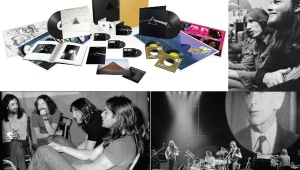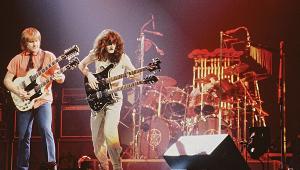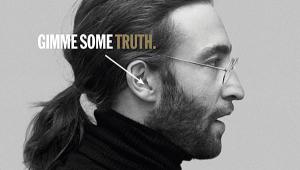Recording and Remixing Revolver Page 7
Martin gave de la Rey “In My Life” from Rubber Soul as an experiment to see what he could do. “I was looking at everything — just pushing everything at him. And, occasionally, the guitars would catch. There wasn’t the right attack on them, things like that. But we worked through it.” Another test piece was “Yellow Submarine.” “I remember, he said to me, ‘I can really separate the effects on ‘Yellow Submarine’ for you.’ And I said, ‘I don’t need those separated. What I need is the kick drum and snare drum separated from the drum kit. That’s what I need done.’ He did it and sent it over, and that’s what unlocked the door for this project.”
In late December 2021, Martin decided not to wait to figure out what he might need from the Revolver multitracks — “I sent him everything.” Exceptions were recordings like “Eleanor Rigby,” where the string octet had filled the first 4-track tape, requiring a reduction mix to a single track on a second tape to allow overdubs. For those, Abbey Road’s Matthew Cocker could do what he does best — line the content of the first reel up with that of the second, perfectly, to allow a new mix, as he had done numerous times before.

“We talked, though, about what I needed. How far we could go. And he would even get to the stage where he could give me. . . a cymbals track.” On “Tomorrow Never Knows,” for example, de la Rey was able to separate out Ringo’s tom tom hits from the rest of his kit on the basic rhythm heard throughout the song, allowing a greater spread than ever heard. And, similarly, the snare and toms are now separated in George’s “I Want to Tell You,” allowing those drums to highlight the songs’ bridges even more.
“Emile ran a first pass, which sounded really good,” Okell recalls. “And then he said, ‘I can improve this. Do you have any recordings of instruments?’” So Okell sent him dozens of samples, not just, say, of Ringo’s own drums, but drums in general — all of which MAL could learn from to create even better separations. “Then he pulled apart drums as one element and we said, ‘Well, how about if we give you kick drums and tom toms, can you pull them out?’ And he said, ‘Yeah, sure,’ and came back with a cymbals track, a toms track, snare and kick tracks. And he did that with every song.”
“You do have to be careful, though, that you don’t lose the dynamic squash of mono [the original mono drum track],” Martin notes. “But now, you can suddenly hear Ringo’s dynamics. The snare and kick are the snare and kick, but as you’d expect to hear them.”
The approach to stereo placement and panning was key to giving fans something they hadn’t had before. Besides Clarke’s de-mix system, Okell notes that he and Martin had tried a number of de-mixing technologies, “But they’re so full of artifacts, you couldn’t really take things apart. We’ve used some to give us a little bit of spread on a rhythm track, just to give it a little bit of something. But not like this, where you can actually take a rhythm guitar and pan it to a whole different side from the rest of it. The quality here was unrivaled. As soon as we realized we could do that without any artifacts or real detriment to the sound of the record, we said, ‘Well, what would make sense to a contemporary ear, with respect to panning? And what’s the nicest balance?’ That’s what’s allowed this remix to spread out so beautifully in the stereo world.”
The balances in Emerick’s original mixes, Okell notes, were already quite good. “For me, it’s not about changing the balance or the tone, just spreading it out in what we would consider now a more conventional stereo layout,” versus, say, piling the entire rhythm track hard left, as one would find on some songs. Typically, the final 4-track (after reduction mixes and overdubs) might be a rhythm track, a guitar solo, and perhaps two vocal tracks. “That’s the general pattern, across the album. Now, we’re able to put the bass and vocal in the center — the way we’re used to listening to music these days.”
He and Martin would work together, deciding what would sound best for any particular recording. Says Martin, “My collaboration with Sam is really important. We can argue. And we just do what feels right. You can pan something, live with it, and then find yourself going, ‘Ohhh, that’s not right.’ It’s just a question of judgement.”
For instance, on “I’m Only Sleeping,” “I moved the guitar away from the drums. . . and it sounded a bit lonely. It sounded like it shouldn’t be moved away, like it shouldn’t be separated. It was a bit like you lost your keys. And then, other times, sometimes you surprise yourself.” “Taxman’s” original rhythm track had George’s guitar, drums and bass all together, all hard left in the original mix, which were separated in de-mixing, allowing Martin to put the guitar to center-right. “Toying with the idea of putting the guitar on the right hand side, away from the drums, was something I didn’t take lightly. It does reduce some impact. There’s something nice about that cohesion, for the snare drum and the guitar to be together. But I think it works. And the drums are rocking.” Adds Okell, “That’s a much more pleasing stereo release to listen to — especially in headphones, which is the dominant way people listen these days.”
On some tracks, such as “Got To Get You Into My Life,” Okell notes, ‘The original had the rhythm section quite subdued. So if you’ve got a way to beef up the drums and give them a bit more power, that really brings it to life.” In others, such as “Here, There and Everywhere” and “For No One,” Ringo’s drums were all but absent in the original mixes. “I remember, when we listened to the spreads we now had, and going, ‘Ringo’s playing drums on this?’” recalls Martin. “They were very quiet in the original. I didn’t know there were drums on ‘For No One.’ But now, here they are, as he played them.”
The approach is always one of taking the original intention, “and taking it a step further,” explains Okell. For instance, on “Tomorrow Never Knows,” “the effects track was panned around in the original stereo mix. We just went a bit more extreme with that panning.” Unlike with Pepper, he says, “where we were actually able to go back into the tape library and find the original effects reels they had used, the source loops for the effects track on Track 2 didn’t exist. The track itself is very much a performance piece. So we treated it as one musical element. We didn’t pull it apart.”
Again, going with the original intention, the team used ADT, perhaps how Martin and Emerick might have, but gave it a new spin. On “I’m Only Sleeping, Okell explains, “In the original, John’s vocal is panned hard left, with the ADT double of it hard right. Here, we placed his vocal in the center, with an ADT spread left and right. And then, when his double-tracked vocal comes in — which isn’t the whole track — that’s panned left, with an ADT to the right,” again, simply providing something that’s slightly more in line with what we’re used to hearing today, while still maintaining the intent and flavor of the original.
Taking a second pass at classic mixes also allows an opportunity to fix mistakes, particularly obvious ones. For example, in the stereo mix of “Eleanor Rigby,” Emerick had applied ADT to the opening chorus vocals, but didn’t pull it out of the mix in time for Paul’s first syllable of the first “Eleanor. . . “That is no longer the case, on the new mix. And on “Yellow Submarine,” the mono mix had properly featured John’s first answering callback, “A life of ease!” after Ringo begins the last verse — but that was always missing from the stereo mix, and is now heard. “Giles was adamant about [making the fix],” Okell explains. “It was one of the first things we did, without much debate.”
To produce his own ADT, Okell mostly did it the old fashioned way — using a second tape machine (in this case, a Studer A80). The process was applied to six of the tracks, just as it had been in the originals — “I’m Only Sleeping,” “Love You To” (on the tabla/sitar track), “And Your Bird Can Sing,” “Doctor Robert,” “I Want to Tell You,” and “Eleanor Rigby.”
More generally, Okell did his mixing “in the box,” as they say — working within Pro Tools, making use of tried-and-true plugins to generate the sounds our ears know. “I use a good Fairchild limiter plugin, as well as EMI REDD desk emulations (to emulate the specific sounds of EMI’s own factory-made original mixing consoles) and other kinds of Abbey Road ’60s gear. The REDD emulation has great EQ. And it has an awesome fuzz.” The two sometimes would supply several mixes to mastering engineer Miles Showall, with varying levels of the REDD desk emulation “for ones where we wanted to make choices in mastering, whether we liked one with slightly more drive or slightly less. On the rockier ones, we tended to like the version that was more ‘crunchy.’”
For the “write-write-write. . . . “ tape-delay effect on “Paperback Writer,” Okell notes, “We’ve leaned more towards the way it was done in the original mono mix.” And, rather than an analog tape delay, he used a digital one — Soundtoys EchoBoy, along with a plug-in representing the [original 4-track] Studer J37’s sound, “to give it a bit of wow, flutter, and distortion,” adding, “I fiddled around with that for ages.”
For rebuilding mixes of songs crafted using speed changes, Okell was thankfully spared having to rebuild them step-by-step, where he would have had to add in parts recorded at different speeds, etc., as Howlett has detailed. Instead, “Matthew Cocker, who does all the analog transfers, synced each of those for us. So if there was a speed change done on a 4-track-to-4-track reduction mix, he would take that into account, and transfer the reels at the correct speed.”
Atmos Aspirations
The album’s Dolby Atmos mixes were mixed by Martin himself, in the Atmos mixing room he built at home during Covid, which he considers to be one of the best in Europe. “It’s like a mastering mix room,” he advises. “Sam says it’s the best control room he’s ever been in.” The mixes were done in late August 2022.
While magical albums like Sgt. Pepper lend themselves to interesting placement of audio elements within the Atmos volume, with a few exceptions, fans of Dolby Atmos will likely find Martin’s Revolver mixes to be on the conservative side — an approach he took with good reason.
“Well, first of all, it’s really content-dependent,” he explains. “For instance, on ‘Eleanor Rigby,’ each member of the octet is in each corner of the room. And the effects for ‘Tomorrow Never Knows’ and ‘Yellow Submarine’ go around you.” With the powerful, signature horn sections of “Got to Get You Into My Life,” Martin puts you within the group of players.
But for a song like “Taxman,” he says, “It’s almost like a horseshoe, instead of a circle. It’s The Beatles — they play together as a band, and that should be the experience you have when listening in Dolby Atmos. You’re watching them play those wonderful songs in front of you” with natural reverberation behind you, courtesy of the true analog re-amping done by Martin and Okell, where they played the mix live at one end of Studio 2 while recording the sound of the room at the other.
“If you pull George’s guitar out too much into the room, it goes away from the drums too much. And it starts sounding like a different member of the band. With Revolver, you don’t want George to be behind you in any way. Or even to the side of you. Because you would never experience that with The Beatles. The Beatles are in front of you. You can hear the guitar plenty clear enough, but it’s got to be connected to everything else. Everything with The Beatles is interconnected.”
He isn’t the only one who thinks so. “Mick Jagger once came in, and he was listening to some Atmos mixes, and he said to me, ‘It’s not really rock and roll, is it?’ It’s because they had things too wide. It doesn’t have to be like that. If you shatter things too much, you lose the directness of the material.” For “Paperback Writer,” the layered voices are heard around you, “But you need the drive of that band.”
Okell agrees. “It very much depends on the style of the song and instrumentation. With strings or a choir or more pad-y things — some music lends itself to that kind of immersive style of mixing. When it’s just bass, guitar, and vocals, it doesn’t always work to pull it apart and stick the guitars behind you. Do you want to hear every single bit distinctly, or do you want to hear just a song? The more discrete every element is, the more it comes apart.”
For Dolby Atmos titles sourced from a streaming service, he notes, “The mix has to be fairly conventional. Most people listen to those mixes on headphones, so it needs to sound good. So that means being a bit more conservative.”
The important thing, says Martin, is that the original intent remains the same. “I don’t want people going, ‘Oh, this is a Giles Martin mix.’ I want people to go, ‘This is The Beatles’ song.’ All Sam and I ever do is try to think, ‘Okay, if my dad or Geoff Emerick had this technology, what would they do with it?’ [Legendary Grammy-winning producer] Peter Asher came up to me, after one of our recent listening sessions for the new mix, and he said something that really mattered to me — he said, ‘It’s exactly what we would have done.’ And that’s the thing about Revolver, and any of The Beatles’ recordings — you can open it out, reveal what’s there, and with The Beatles, it’s a thing of great beauty.”
Related
Here, There and Spatially Everywhere: Giles Martin on Mixing Revolver in Atmos























































